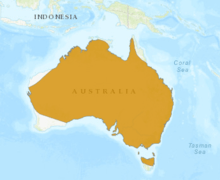White-browed woodswallow
The white-browed woodswallow (Artamus superciliosus) is a medium-sized (~19 cm) passerine bird endemic Australia.[2] The white-browed woodswallow has very distinctive plumage consisting of white brow over a black head with the upper body being a deep blue-grey and with a chestnut under body.[2] The females are paler then the males.[3] The white-browed woodswallow has a bifurcated (divided) tongue like most woodswallows.[4]
| White-browed woodswallow | |
|---|---|
 | |
| male with spider | |
 | |
| female with spider | |
| Scientific classification | |
| Kingdom: | Animalia |
| Phylum: | Chordata |
| Class: | Aves |
| Order: | Passeriformes |
| Family: | Artamidae |
| Genus: | Artamus |
| Species: | A. superciliosus |
| Binomial name | |
| Artamus superciliosus (Gould, 1837) | |
 | |
White-browed woodswallows are highly nomadic travelling in pairs to flocks from hundred to thousands of birds.[4] They often wander irregularly around inland Australia, usually heading north for winter in the Northern Territory and central Queensland, and south in spring for nesting.[3] White-browed woodswallows regularly associate with flocks of the masked woodswallows.[4]
Distribution
The white-browed wood-swallow is found throughout Australia with higher concentrations in central New South Wales.[3] According to the IUCN Redlist, wood-swallow are considered least of concern.[5]
Ecology and Habitat
They inhabit margins of rainforests, woodlands, inland/coastal scrubs, golf courses, vineyards, suburban streets and arid areas of Australia.[2] They make a ‘tchip-tchip’ call similar to masked woodswallows.[3][2]
Reproduction
Breeding occurs between August and December or after rain.[2] White-browed woodswallows nest in shrubs, forks of trees, hollow stumps or posts, the nest are normally made of twigs, grass and rootlets.[3][2] The eggs are white/grey, spotted, or blotched brown-grey.[2] A clutch will usually consist of 2 to 3 eggs.[2]
Diet
White-browed woodswallows feed on nector when blossoms are available but mainly feed on insects.[2]
References
- BirdLife International (2012). "Artamus superciliosus". IUCN Red List of Threatened Species. 2012. Retrieved 26 November 2013.CS1 maint: ref=harv (link)
- Prizzey, Graham; Knight, Frank (1980). Prizzey, Sarah (ed.). The Field Guide to the Birds of Australia (9 ed.). Sydney: Collins. p. 418.
- Morcombe, Michael (2011). The Michael Morcombe eGuide to Australian Birds. Steve Parish Publishing.
- Simpson, Ken; Day, Nicolas (1993). Field Guide to the Birds of Australia. Melbourne: Lloyd O'Neil. pp. 252, 328.
- "The IUCN Red List of Threatened Species". IUCN Red List of Threatened Species. Retrieved 2019-07-07.
External links
- ABID Images
- White-browed woodswallow videos, photos & sounds on the Internet Bird Collection
- https://commons.wikimedia.org/wiki/File:WhitebrowedWoodswallowRangemap.png
| Wikimedia Commons has media related to Artamus superciliosus. |
| Wikispecies has information related to Artamus superciliosus |
